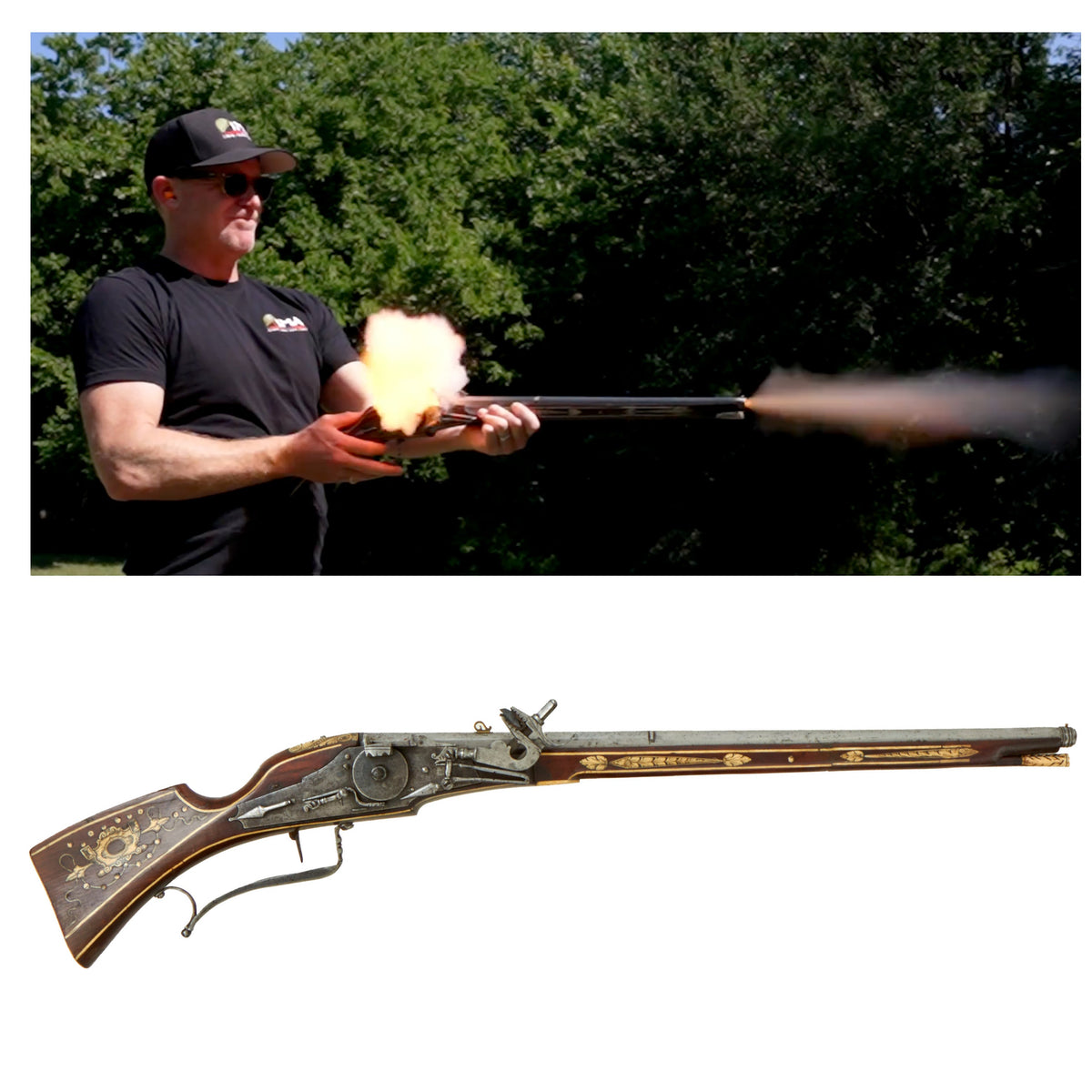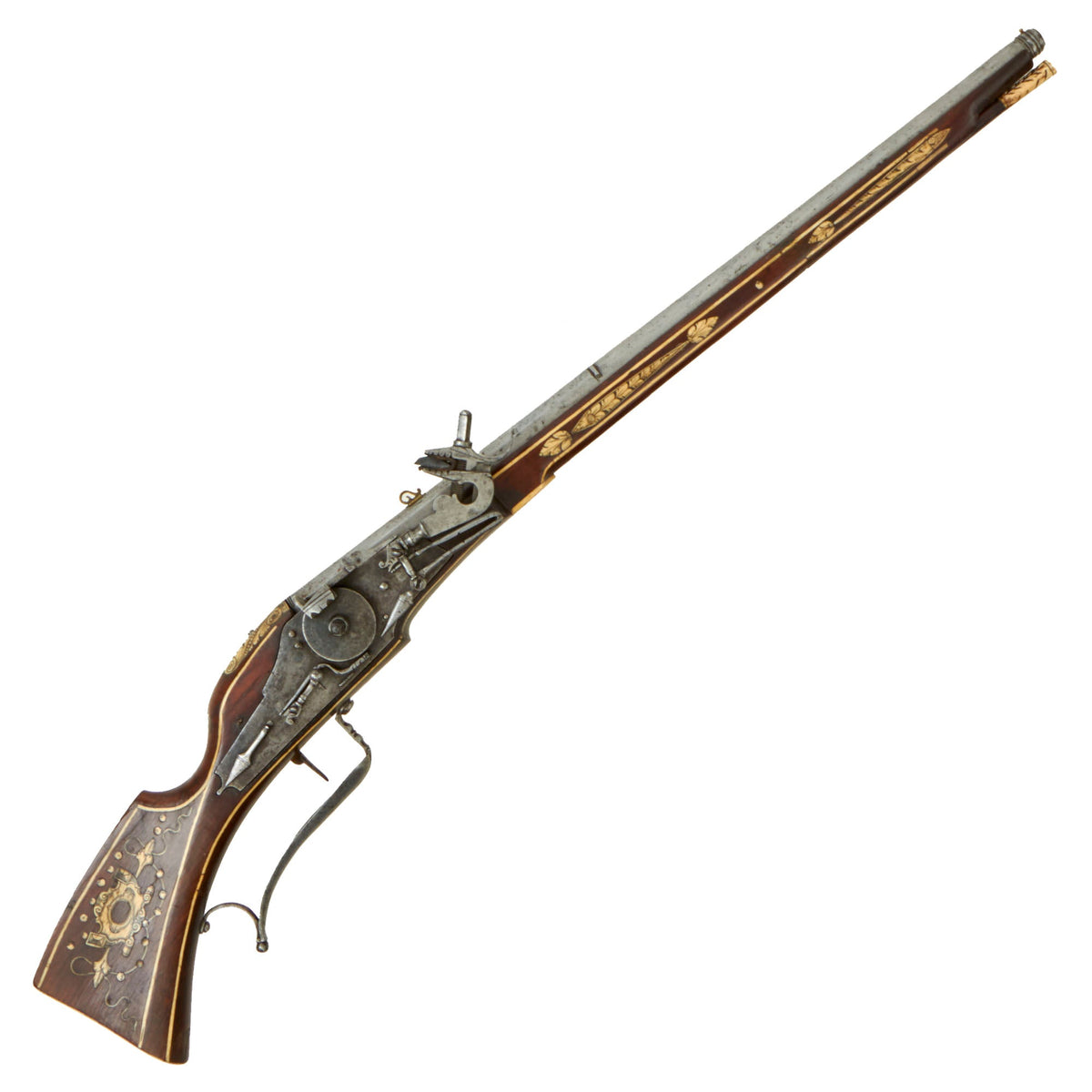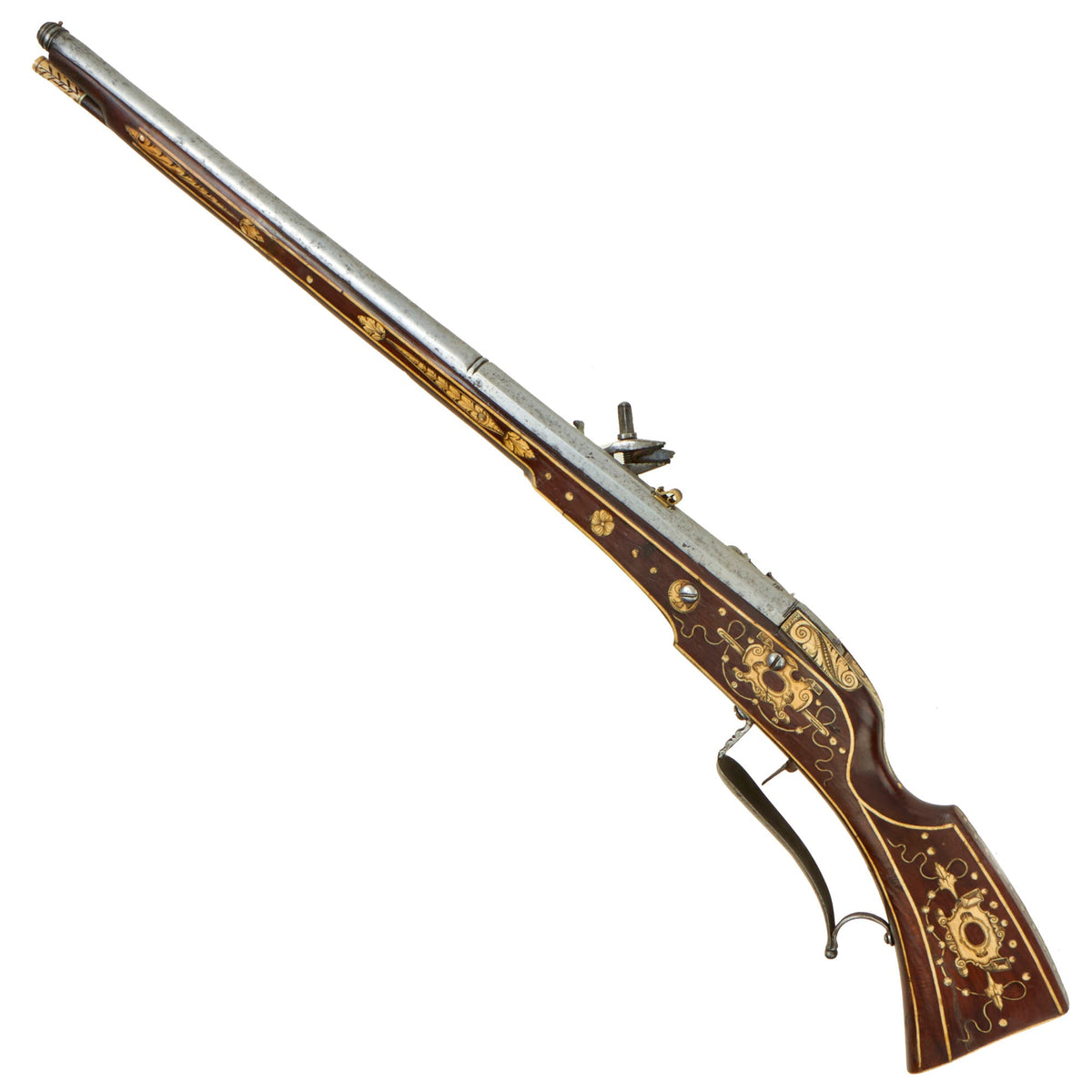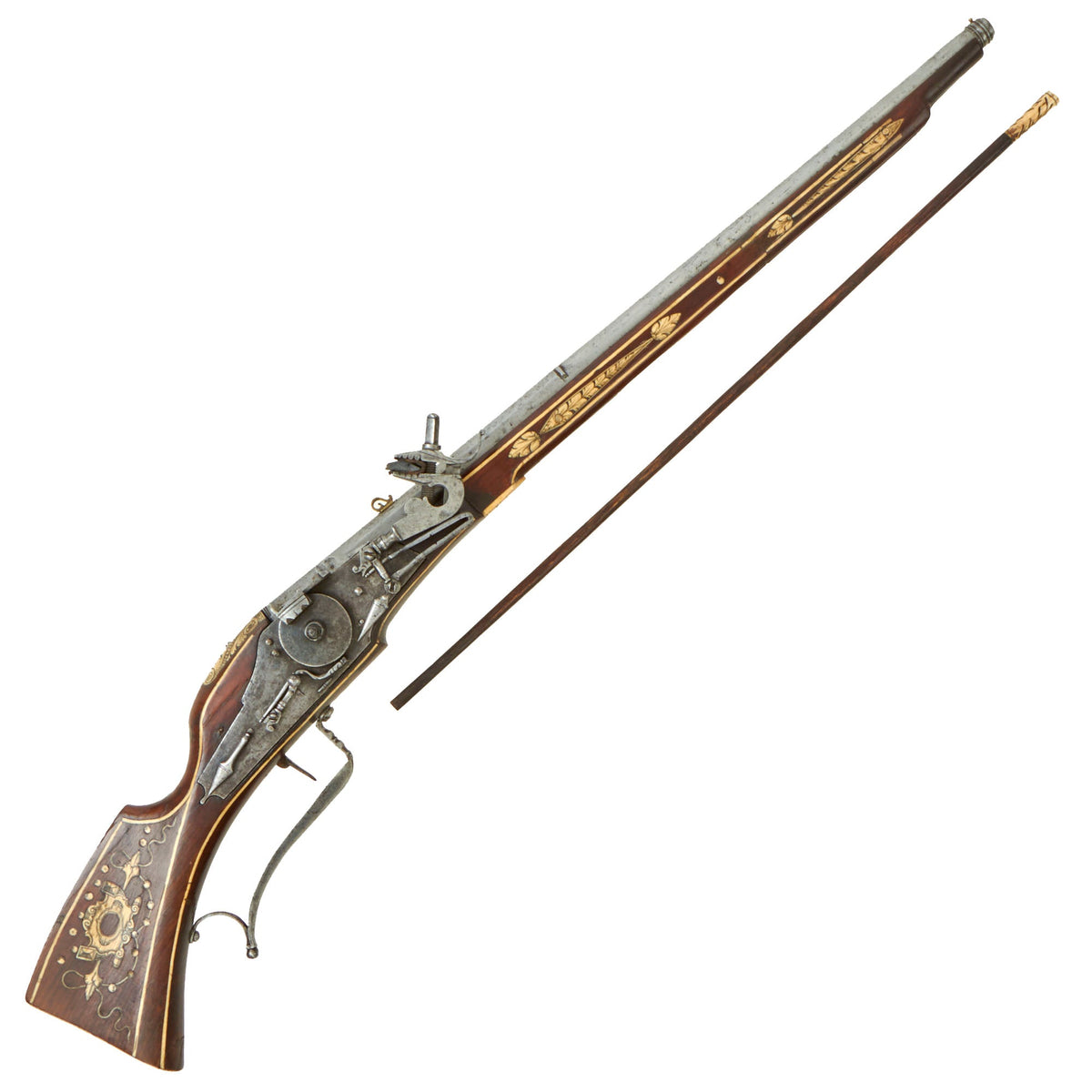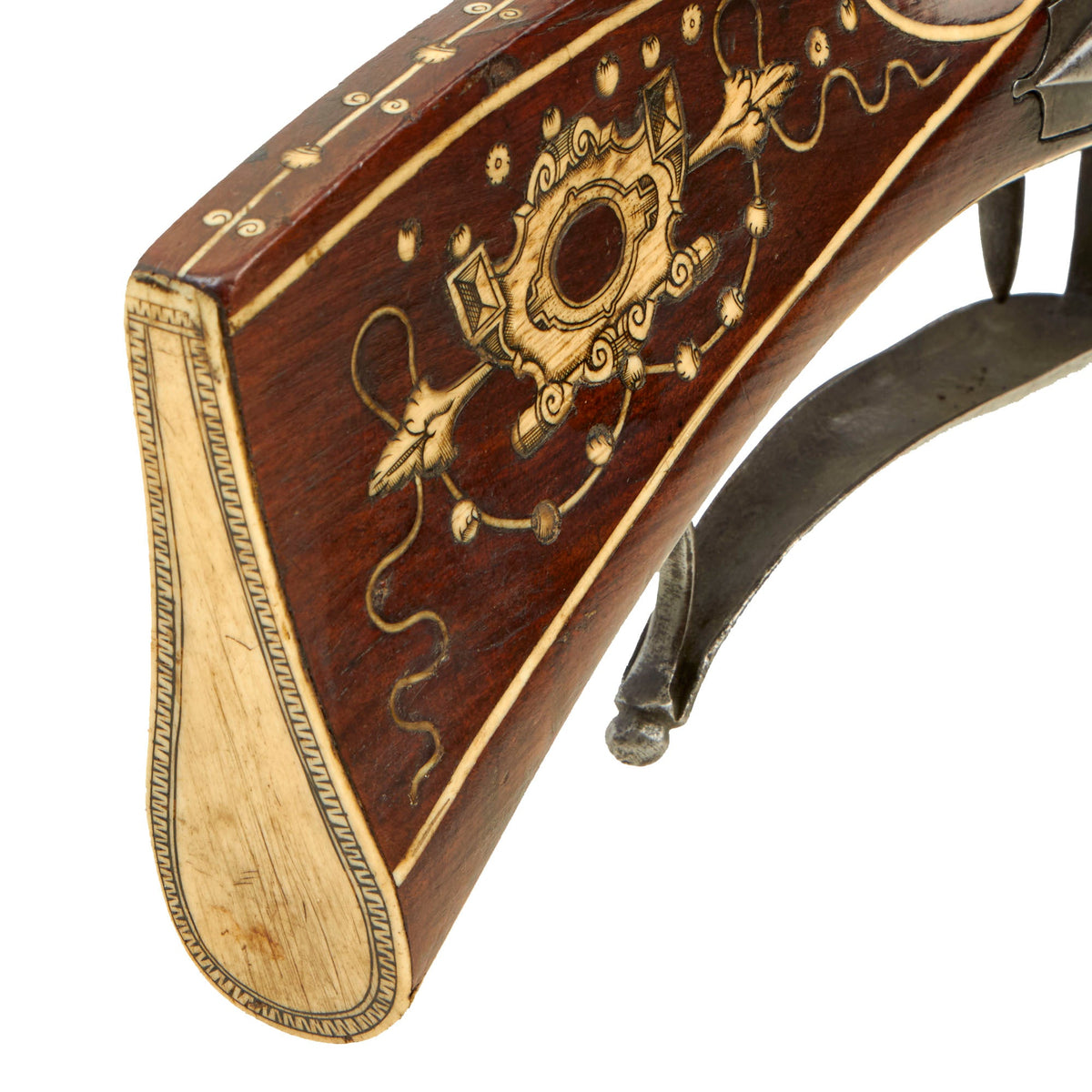Original Early 17th Century Wheel-Lock Carbine Guard of Prince-Archbishop of Salzburg Wolf-Dietrich Von Raitenau – As Seen on History Channel Pawn Stars Original Items
$ 31.995,00 $ 7.998,75
This very Wheel-lock was featured and test fired on an episode of History Channel’s Pawn Stars in October 2023. You can watch it on the episode below:
Original Item: Originating from the Princely Residence, Salzburg; most likely included in the booty transferred by Bavarian troops to the Munich city Zeughaus circa 1809, and subsequently included in the sales from the Zeughaus following the First World War.
This most elegant wheel-lock carbine belongs to a small but very well-known series made to equip a company of troops within the personal guard Wolf-Dietrich von Raitenau, Prince-Archbishop of Salzburg (r.1587-1612, d.1617). An archival record tells us that in 1605, under the command of a captain, his deputy and a drum-major, the guard numbered 36 soldiers armed with carbines, together with 29 halberdiers (see von Grumppenberg 1987, p. 265).
Produced over a span of perhaps more than sixteen years, the von Raitenau series of carbines differ in some details of their construction, the locks most noticeably, and this is illustrated perfectly by the two examples now in the Bayerisches Nationalmuseum in Munich (Inv.-Nr. W 4830 and 4857), see von Schalkhaußer 1967, nos. 15-16. All, however, conform to very similar proportions, to the relatively restrained designs of the engraved horn inlay of the stocks, and to the repeated inclusion of the decorative pierced and threaded cartouche formed in the rollwerk style of the German high renaissance, which is easily apparent on the carbine under discussion. The earliest of these carbines is dated 1594 and is preserved in the Landesmuseum Kärnten, Klagenfurt, while two others, attributed to 1590, are in the former imperial collection of the Kunsthistorisches museum in Vienna, see Schedelmann 1972, pp. 44 and 46 (A 807 and A 808).
Nearly identical examples found at in the collections of the following museums at thee links: Art Institute of Chicago and the Worcester Art Museum.
Wolf-Dietrich von Raitenau was born in 1559 and steered by his family away from his early interest in a military career to one in the church. Rising quickly through the hierarchy of the Cathedral Chapter of Salzburg von Raitenau was appointed Prince-Archbishop of Salzburg in 1587, the territories held by the archbishopric being a part of the Holy Roman Empire under the Emperor Rudolf II.
Salzburg flourished within the greater part of von Raitenau’s reign, but his rule ended as a consequence of a dispute with Bavaria over the trade in salt and von Raitenau’s refusal to join the Catholic League. In October 1611 his troops invaded the Berchtesgaden Provostry, territory also claimed by the ruling Bavarian Wittlesbachs. The Bavarians retaliated by marching into the Salzburg lands. At this point Rudolf II abandoned his support of the Salzburg Archbishopric, and von Raitenau was captured while in flight through Carinthia. He was imprisoned in the Hohensalzburg castle for the remainder of his life, he died in 1617.
The mark struck on the breech of the barrel of this carbine should almost certainly be attributed either to the gun-maker Georg Zellner working in Zell am Wallersee, a town on the northerly edge of the former independent Prince-bishopric of Salzburg, or perhaps to the town itself. While this exact mark, without the additional initials G or GZ, is not recorded in the lexicon Neue Støckel with an attribution to Georg Zellner, the letter Z between two pellets is the salient feature both of the existing mark attributed to Georg Zellner (active circa 1594-1634), and of the mark used by his son, Hans Zellner (1610-80): see Heer 1979, p. 1432, nos. 2740 and 8597 respectively. The barrels of other carbines within the von Raitenau series are both struck with Georg Zellner’s recognised mark (referenced above) and alternatively with the mark found on the barrel of the present carbine. In both instances the locks of these carbines may, or may not be, struck with the mark of other makers of gun locks.
Examples of the mark identical to that on the breech of this carbine are found on a number of carbines from the von Raitenau series; two are preserved in the Salzburg Museum (Inv. Nr. W 275 and W 1068) and a third is in the Salzburg Residenz, the former palace of the Prince-Archbishops: see von Grumppenberg 1987, cat. nos. 151, 156 and 154 respectively. Another is in the Philadelphia Museum of Art, see von Kienbusch 1963, cat. no. 637, with further reference to one formerly in the Hanoverian Royal Collection. A further example is in the Bayerisches Nationalmuseum (Inv.-Nr. IV E 153), see Schalkhaußer 1988, cat. no. 14. This last example, together with the two in this museum cited earlier, were almost certainly a part of the quantity of luxurious arms and equipment belonging to von Raitenau’s guard which was looted by Bavarian troops, either on about the occasion in 1612 of his capture by the Bavarians, or in 1809, at the transferral of the Salzburg lands to Bavaria.
The barrel formed in two stages with moulded girdle between, the breech section octagonal, struck with maker’s mark attributed to Georg Zellner (in a shield, Z flanked by pellets), fitted with brass standing back-sight formed as an openwork scroll and the muzzle decorated with a pronounced double moulding also seating the foresight bead. With flat lock and solid flat wheel-cover each retaining some original blued finish, and fitted with sliding pan-cover, safety-catch moving on a long external spring extending from below the wheel, and the dog formed with a scroll-shaped neck flattened on the outer side. With fruitwood full stock inlaid over its length with a series of engraved white horn plaques arranged within plain horn linear borders and segmental lines, involving stylised leaf ornament in elongated plaques inlaid over the fore-end, a pierced rollwerk cartouche opposite the lock threaded with a scrolling line strung with ballflowers, a similar device decorating both sides of the butt, and a pair of plaques engraved with S-shaped leafy scrolls inlaid about the barrel tang. With iron trigger-guard, an engraved horn plaque over the mouth of the ramrod channel, border-engraved horn butt-plate, and original wooden ramrod with engraved horn tip.
Approximate Specifications:
Year of Manufacture: Circa 1600 – 1610
Caliber: .45 inches
Ammunition Type: Lead Ball & Powder
Barrel Length: 22.25 inches
Overall Length: 32.5 inches
Action: Wheellock
Feed System: Muzzle-Loaded
A wheellock, wheel-lock or wheel lock is a friction-wheel mechanism which creates a spark that causes a firearm to fire. It was the next major development in firearms technology after the matchlock and the first self-igniting firearm. Its name is from its rotating steel wheel to provide ignition. Developed in Europe around 1500, it was used alongside the matchlock and was later superseded by the snaplock (1540s), the snaphance (1560s) and the flintlock (c. 1610s).
The wheellock works by spinning a spring-loaded steel wheel against a piece of pyrite to generate intense sparks, which ignite gunpowder in a pan, which flashes through a small touchhole to ignite the main charge in the firearm’s barrel. The pyrite is clamped in vise jaws on a spring-loaded arm (or ‘dog’), which rests on the pan cover. When the trigger is pulled, the pan cover is opened, and the wheel is rotated, with the pyrite pressed into contact.
A close modern analogy of the wheellock mechanism is the operation of a lighter, where a toothed steel wheel is spun in contact with a piece of sparking material to ignite the liquid or gaseous fuel.
A wheellock firearm had the advantage that it can be instantly readied and fired even with one hand, in contrast to the then-common matchlock firearms, which must have a burning cord of slow match ready if the gun might be needed and demanded the operator’s full attention and two hands to operate. On the other hand, wheellock mechanisms were complex to make, making them relatively costly.
NOTE: International orders of antique firearms MUST be shipped using UPS WW Services (courier). USPS Priority Mail international will not accept these. International customers should always consult their country’s antique gun laws prior to ordering.
Fast Shipping with Professional Packaging
Thanks to our longstanding association with UPS FedEx DHL, and other major international carriers, we are able to provide a range of shipping options. Our warehouse staff is expertly trained and will wrap your products according to our exact and precise specifications. Prior to shipping, your goods will be thoroughly examined and securely secured. We ship to thousands clients each day across multiple countries. This shows how we're dedicated to be the largest retailer on the internet. Warehouses and distribution centres can be located throughout Europe as well as the USA.
Note: Orders with more than one item will be assigned a processing date depending on the item.
Before shipping before shipping, we'll conduct a thorough inspection of the items you have ordered. Today, the majority of orders will be delivered within 48 hours. The delivery time will be between 3-7 days.
Returns
The stock is dynamic and we cannot completely manage it because multiple stakeholders are involved, including our factory and warehouse. So the actual stock may alter at any time. It's possible that you may not receive your order once the order has been made.
Our policy is valid for a period of 30 days. If you don't receive the product within 30 days, we are not able to issue a refund or an exchange.
You can only return an item if it is unused and in the same state as the day you received it. You must have the item in its original packaging.
Related products
Uncategorized
Uncategorized
Uncategorized
Armored Burgonet Helmet & Polearm from Scottish Castle Leith Hall Circa 1700 Original Items
Uncategorized
Uncategorized
Uncategorized
Uncategorized
Uncategorized
Uncategorized
Australian WWII Owen MK1 Machine Carbine SMG Custom Fabricated Replica with Sling Original Items
Uncategorized
Uncategorized
Uncategorized
Uncategorized
Uncategorized
Uncategorized
Uncategorized
Armoured Fighting Vehicles of the World: AFVs of World War One (Hardcover Book) New Made Items
Uncategorized
